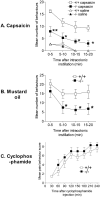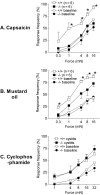Deficits in visceral pain and referred hyperalgesia in Nav1.8 (SNS/PN3)-null mice
- PMID: 12351708
- PMCID: PMC6757795
- DOI: 10.1523/JNEUROSCI.22-19-08352.2002
Deficits in visceral pain and referred hyperalgesia in Nav1.8 (SNS/PN3)-null mice
Abstract
The tetrodotoxin-resistant sodium channel alpha subunit Nav1.8 is expressed exclusively in primary sensory neurons and is proposed to play an important role in sensitization of nociceptors. Here we compared visceral pain and referred hyperalgesia in Nav1.8-null mice and their wild-type littermates in five tests that differ in the degree to which behavior depends on spontaneous, ongoing firing in sensitized nociceptors. Nav1.8-null mice showed normal nociceptive behavior provoked by acute noxious stimulation of abdominal viscera (intracolonic saline or intraperitoneal acetylcholine). However, Nav1.8-null mutants showed weak pain and no referred hyperalgesia to intracolonic capsaicin, a model in which behavior is sustained by ongoing activity in nociceptors sensitized by the initial application. Nav1.8-null mice also showed blunted pain and hyperalgesia to intracolonic mustard oil, which sensitizes nociceptors but also provokes tissue damage. To distinguish between a possible role for Nav1.8 in ongoing activity per se and ongoing activity after sensitization in the absence of additional stimuli, we tried a visceral model of tonic noxious chemical stimulation, cyclophosphamide cystitis. Cyclophosphamide produces cystitis by gradual accumulation of toxic metabolites in the bladder. In this model, Nav1.8-null mice showed normal responses. There were no differences between null mutants and their normal littermates in tissue damage and inflammation evoked by any of the stimuli tested, suggesting that the behavioral differences are not secondary to impairment of inflammatory responses. We conclude that there is an essential role for Nav1.8 in mediating spontaneous activity in sensitized nociceptors.
Figures


Similar articles
-
Deficits in visceral pain and hyperalgesia of mice with a disruption of the tachykinin NK1 receptor gene.Neuroscience. 2000;98(2):345-52. doi: 10.1016/s0306-4522(00)00148-2. Neuroscience. 2000. PMID: 10854767
-
Visceral and somatic pain modalities reveal NaV 1.7-independent visceral nociceptive pathways.J Physiol. 2017 Apr 15;595(8):2661-2679. doi: 10.1113/JP272837. Epub 2017 Mar 1. J Physiol. 2017. PMID: 28105664 Free PMC article.
-
Effects of Tetrodotoxin in Mouse Models of Visceral Pain.Mar Drugs. 2017 Jun 21;15(6):188. doi: 10.3390/md15060188. Mar Drugs. 2017. PMID: 28635651 Free PMC article.
-
[The role of tetrodotoxin-resistant sodium channels in pain sensation studied on sns-knockout mice].Nihon Rinsho. 2001 Sep;59(9):1688-97. Nihon Rinsho. 2001. PMID: 11554037 Review. Japanese.
-
Peripheral and central mechanisms of cutaneous hyperalgesia.Prog Neurobiol. 1992;38(4):397-421. doi: 10.1016/0301-0082(92)90027-c. Prog Neurobiol. 1992. PMID: 1574584 Review.
Cited by
-
Activation of cannabinoid receptor 2 inhibits experimental cystitis.Am J Physiol Regul Integr Comp Physiol. 2013 May 15;304(10):R846-53. doi: 10.1152/ajpregu.00585.2012. Epub 2013 Mar 20. Am J Physiol Regul Integr Comp Physiol. 2013. PMID: 23515618 Free PMC article.
-
Involvement of the endogenous hydrogen sulfide/Ca(v) 3.2 T-type Ca2+ channel pathway in cystitis-related bladder pain in mice.Br J Pharmacol. 2012 Oct;167(4):917-28. doi: 10.1111/j.1476-5381.2012.02060.x. Br J Pharmacol. 2012. PMID: 22646666 Free PMC article.
-
Sodium channelopathies and pain.Pflugers Arch. 2010 Jul;460(2):249-63. doi: 10.1007/s00424-009-0779-3. Epub 2010 Jan 26. Pflugers Arch. 2010. PMID: 20101409 Review.
-
Acupuncture points injection mitigates chronic pain through transient receptor potential V1 in mice.Iran J Basic Med Sci. 2022 Apr;25(4):451-459. doi: 10.22038/IJBMS.2022.60121.13327. Iran J Basic Med Sci. 2022. PMID: 35656078 Free PMC article.
-
New insights into molecular targets for urinary incontinence.Indian J Pharmacol. 2010 Oct;42(5):261-6. doi: 10.4103/0253-7613.69980. Indian J Pharmacol. 2010. PMID: 21206614 Free PMC article.
References
-
- Akopian AN, Souslova V, England S, Okuse K, Ogata N, Ure J, Smith A, Kerr BJ, McMahon SB, Boyce S, Hill RG, Stanfa L, Dickenson AH, Wood JN. The tetrodotoxin-resistant sodium channel SNS has a specialized function in pain pathways. Nat Neurosci. 1999;2:541–548. - PubMed
-
- Amaya F, Decosterd I, Samad T, Plumpton C, Tate S, Mannion RJ, Costigan M, Woolf CJ. Diversity of expression of the sensory neuron-specific TTX-resistant voltage-gated sodium ion channels SNS and SNS2. Mol Cell Neurosci. 2000;15:331–342. - PubMed
-
- Baker MD, Wood JN. Involvement of Na+ channels in pain pathways. Trends Pharmacol. 2001;22:27–31. - PubMed
-
- Caterina MJ, Julius D. The vanilloid receptor: a molecular gateway to the pain pathway. Annu Rev Neurosci. 2001;24:487–517. - PubMed
Publication types
MeSH terms
Substances
Grants and funding
LinkOut - more resources
Full Text Sources
Other Literature Sources
Medical
Molecular Biology Databases
